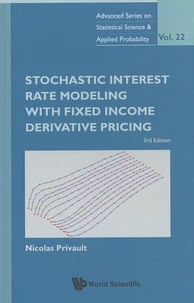Understanding Markov Chains. Examples and Applications
2nd edition
Par : Formats :
- Paiement en ligne :
- Livraison à domicile ou en point Mondial Relay indisponible
- Retrait Click and Collect en magasin gratuit
- Réservation en ligne avec paiement en magasin :
- Indisponible pour réserver et payer en magasin
- Nombre de pages369
- PrésentationBroché
- Poids0.615 kg
- Dimensions15,4 cm × 23,4 cm × 2,5 cm
- ISBN978-981-13-0658-7
- EAN9789811306587
- Date de parution15/08/2018
- CollectionUndergraduate Mathematics Seri
- ÉditeurSpringer Science
Résumé
This book provides an undergraduate-level introduction to discrete and continuous-time Markov chains and their applications, with a particular focus on the first step analysis technique and its applications to average hitting times and ruin probabilities. It also discusses classical topics such as recurrence and transience, stationary and limiting distributions, as well as branching processes. It first examines in detail two important examples (gambling processes and random walks) before presenting the general theory itself in the subsequent chapters.
It also provides an introduction to discrete-time martingales and their relation to ruin probabilities and mean exit times, together with a chapter on spatial Poisson processes. The concepts presented are illustrated by examples, 138 exercises and 9 problems with their solutions.
It also provides an introduction to discrete-time martingales and their relation to ruin probabilities and mean exit times, together with a chapter on spatial Poisson processes. The concepts presented are illustrated by examples, 138 exercises and 9 problems with their solutions.
This book provides an undergraduate-level introduction to discrete and continuous-time Markov chains and their applications, with a particular focus on the first step analysis technique and its applications to average hitting times and ruin probabilities. It also discusses classical topics such as recurrence and transience, stationary and limiting distributions, as well as branching processes. It first examines in detail two important examples (gambling processes and random walks) before presenting the general theory itself in the subsequent chapters.
It also provides an introduction to discrete-time martingales and their relation to ruin probabilities and mean exit times, together with a chapter on spatial Poisson processes. The concepts presented are illustrated by examples, 138 exercises and 9 problems with their solutions.
It also provides an introduction to discrete-time martingales and their relation to ruin probabilities and mean exit times, together with a chapter on spatial Poisson processes. The concepts presented are illustrated by examples, 138 exercises and 9 problems with their solutions.





